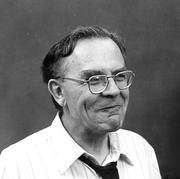
Back Geoffrey Wilkinson Afrikaans جوفري ولكنسون Arabic جفری ویلکینسون AZB Джэфры Уілкінсан Byelorussian Джефри Уилкинсън Bulgarian জিওফ্রে উইল্কিন্সন Bengali/Bangla Geoffrey Wilkinson Catalan Geoffrey Wilkinson Czech Geoffrey Wilkinson Danish Geoffrey Wilkinson German
Sir Geoffrey Wilkinson | |
|---|---|
 Wilkinson, c. 1976 | |
| Born | 14 July 1921 Todmorden, West Riding of Yorkshire, England |
| Died | 26 September 1996 (aged 75) London, England |
| Nationality | British |
| Alma mater | Imperial College London (PhD) |
| Known for | Homogeneous transition metal catalysis |
| Awards |
|
| Scientific career | |
| Fields | Inorganic chemistry |
| Institutions | |
| Thesis | Some physico-chemical observations on hydrolysis in the homogeneous vapour phase (1946) |
| Doctoral advisor | Henry Vincent Aird Briscoe[2] |
| Other academic advisors | Glenn T. Seaborg (post doctoral advisor) |
| Doctoral students | |
| Other notable students | Richard A. Andersen (postdoc) |
Sir Geoffrey Wilkinson FRS[1] (14 July 1921 – 26 September 1996) was a Nobel laureate English chemist who pioneered inorganic chemistry and homogeneous transition metal catalysis.[6][7]
- ^ a b Green, M. L. H.; Griffith, W. P. (2000). "Sir Geoffrey Wilkinson. 14 July 1921 -- 26 September 1996: Elected 18 March 1965". Biographical Memoirs of Fellows of the Royal Society. 46: 593–606. doi:10.1098/rsbm.1999.0103.
- ^ Cite error: The named reference
NobelFoundationBiowas invoked but never defined (see the help page). - ^ Davison, Alan (1962). Studies on the chemistry of transition metal carbonyls. ethos.bl.uk (PhD thesis). Imperial College London. hdl:10044/1/13205.
- ^ Green, Malcolm L. H.; Cummins, Christopher C.; Kronauge, James F. (2017). "Alan Davison. 24 March 1936 – 14 November 2015". Biographical Memoirs of Fellows of the Royal Society. 63: 197–213. doi:10.1098/rsbm.2017.0004. ISSN 0080-4606.
- ^ Green, Malcolm Leslie Hodder Green (1958). A study of some transitional metal hydrides and olefin complexes. london.ac.uk (PhD thesis). Imperial College London.
- ^ "Sir Geoffrey Wilkinson 1921−1996 IN MEMORIAM". Inorganic Chemistry. 35 (26): 7463–7464. 1996. doi:10.1021/ic961299i.
- ^ "Geoffrey Wilkinson Patents". Archived from the original on 7 November 2017. Retrieved 31 October 2006.
© MMXXIII Rich X Search. We shall prevail. All rights reserved. Rich X Search